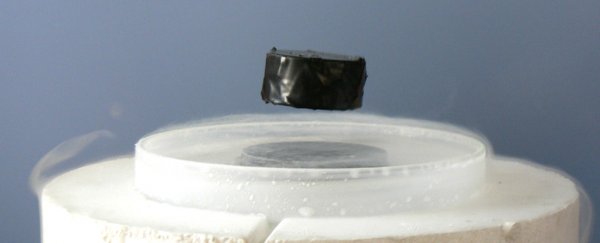For the first time, researchers have achieved superconductivity - the phenomenon of electrical conductivity with zero resistance - in a material that's not a superconductor.
The new technique demonstrates a concept that was first proposed back in the 1970s, but until now had never been proven, and it could lead to ways to make existing superconductors, like the ones used in MRI machines or maglev trains, cheaper and more efficient at higher temperatures.
" Superconductivity is used in many things, of which MRI ( magnetic resonance imaging) is perhaps the best known," said lead researcher Paul C. W. Chu from the University of Houston.
But superconductive materials could revolutionise a whole range of other industries if they were more commercially viable. Not only can superconductors be used to build super-fast, frictionless transport systems, like maglev trains and the Hyperloop, they could also make our electricity grids a whole lot more efficient.
Right now, the materials we use to transmit electricity from power plants to our homes lose as much as 10 percent of the energy along the journey. But superconductors wouldn't lose any electricity at all, so utility companies could provide us with more power without needing to generate any more electricity.
What's holding back all of these applications is that commercial superconductors materials need to be cooled down to around –269.1 degrees Celsius in order achieve zero electrical resistance, which is incredibly expensive and energy intensive.
Even the best superconductors still being tested in the lab can't achieve superconductivity above –70 degrees Celsius. And researchers are struggling to get that temperature, known as critical temperature (or Tcs), closer to room temperature.
For decades, scientists have thought a better way to boost superconductivity temperatures would be to find a way to induce superconductivity in non-superconductive materials.
The idea is that if researchers can figure out a way to make regular materials superconductive, it would open up new ways to make superconductive materials work at even higher temperatures.
And now the University of Houston team has taken the first step, by inducing superconductivity at the point where two phases of a material meet - known as the interface.
They achieved this in calcium iron arsenide (CaFe2As2), a material that's non-superconductive.
"One way that has long been proposed to achieve enhanced Tcs is to take advantage of artificially or naturally assembled interfaces," the researchers write.
"The present work clearly demonstrates that high Tcs in the well-known non-superconducting compound CaFe2As2 can be induced by antiferromagnetic/metallic layer stacking and provides the most direct evidence to date for the interface-enhanced Tcs in this compound."
So how does it work? The idea that superconductivity could be induced - or even enhanced - at the interface where two different materials come together was first proposed in the 1970s.
But although many research teams have attempted to show that it works, past experiments that achieved superconductivity could not exclude that the effects of stress or chemical doping weren't messing with the results, so the effect was never validated until now.
To verify what was happening, the Houston researchers worked in ambient pressure and used undoped calcium iron arsenide.
They then took the material and heated it to 350 degrees Celsius to achieve a process known annealing, where the material cools slowly after being heated.
This process caused two distinct phases in the calcium iron arsenide to occur as it cools unevenly.
While neither of those two phases were superconducting, the team was able to detect superconductivity at the point where the two phases coexist - proving that the interface hypothesis is real.
The calcium iron arsenide achieved superconductivity at around 25 Kelvin, which is roughly –248.15 degrees Celsius, so it's still not going to be of much use for industry.
But the next step will be to use this same process to find ways to make existing high-temperature superconductors more efficient at these interface points.
There's a long way to go before this technique is used commercially, but it's a promising step towards developing cheaper and better superconducting materials in the future.
Bring on those levitating trains.
The research has been published in the Proceedings of the National Academy of Sciences.
